The B2B Content Marketing Report
Written by Brian Dean
We analyzed 502 B2B companies to better understand how they approach content marketing. And to help identify content marketing approaches that work best in the B2B space.
Specifically, we looked at:
- How many B2B companies have a blog
- The types of content are they publishing
- How much organic traffic B2B blogs receive each month
- The characteristics of top performing B2B content
- And more
Now it’s time to share what we discovered.
Our summary findings are as follows:
1. 72% of B2B companies have a blog. Put another way, 28% of B2B companies don’t have a blog.
2. Only 8% of B2B companies solely use their blogs for sharing company-focused, PR-style content.
3. B2B blogs that create education content receive 52% more organic traffic than those that mainly publish content about their company.
4. Only 29% of B2B companies allow comments on their blog posts.
5. 65% of B2B companies use stock images in their blog posts.
6. The most popular call-to-action in B2B content is to highlight “related posts” or “related content”.
7. 35% of companies used “subscribe to our newsletter” as a prominent call-to-action on their blogs.
8. Only 24% of companies use pop-ups on their blogs.
9. On average, B2B blogs receive 282 visits from organic search each month.
10. Top-performing B2B blog posts receive an average of 99 shares on social media and 49 visits per month from organic search.
72% of B2B Companies Have a Blog
Our research found that nearly 3 out of 4 B2B companies have a blog.
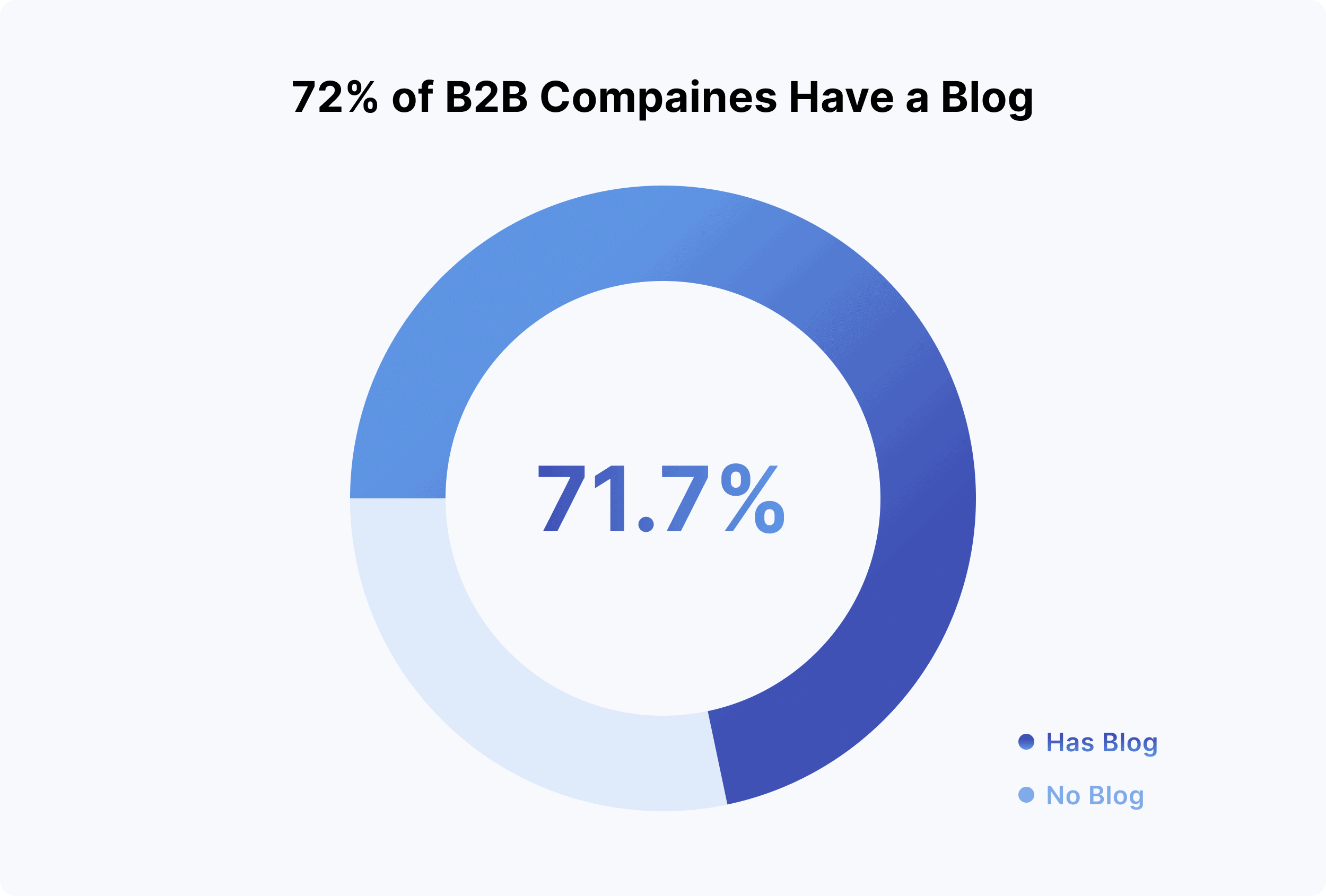
Or put another way, 142 of our 502 (28.3%) of B2B companies don’t have a blog.
For most companies, their blog is the main hub of their content marketing efforts. And a key source of organic traffic.
Without a blog, it strongly suggests that 28% of B2B companies are making little investment in their content marketing.
According to FocusVision, B2B decision makers typically consume 13 pieces of content during the buying cycle. Interestingly, the majority of that content is read directly from the vendor’s website.
Which is probably why 46% of B2B marketers plan on investing more in content marketing in the future.
According to our research, the majority of B2B businesses are invested in content marketing and SEO.
However, a fair number of B2B companies are either not using content as part of their marketing approach. Or their content marketing is happening off-site (for example, on social media networks like LinkedIn).
The rest of this report mainly focuses on the majority of B2B companies that do use blogging as part of their content marketing strategy.
Key Takeaway: 28% of B2B companies don’t use blogging as part of their content marketing strategy.
61% of B2B Companies Use WordPress as Their CMS
Across the 360 SaaS companies with existing blogs, we identified 25 different content management systems in use. The most popular choice was WordPress, used by 220 (61%) companies.
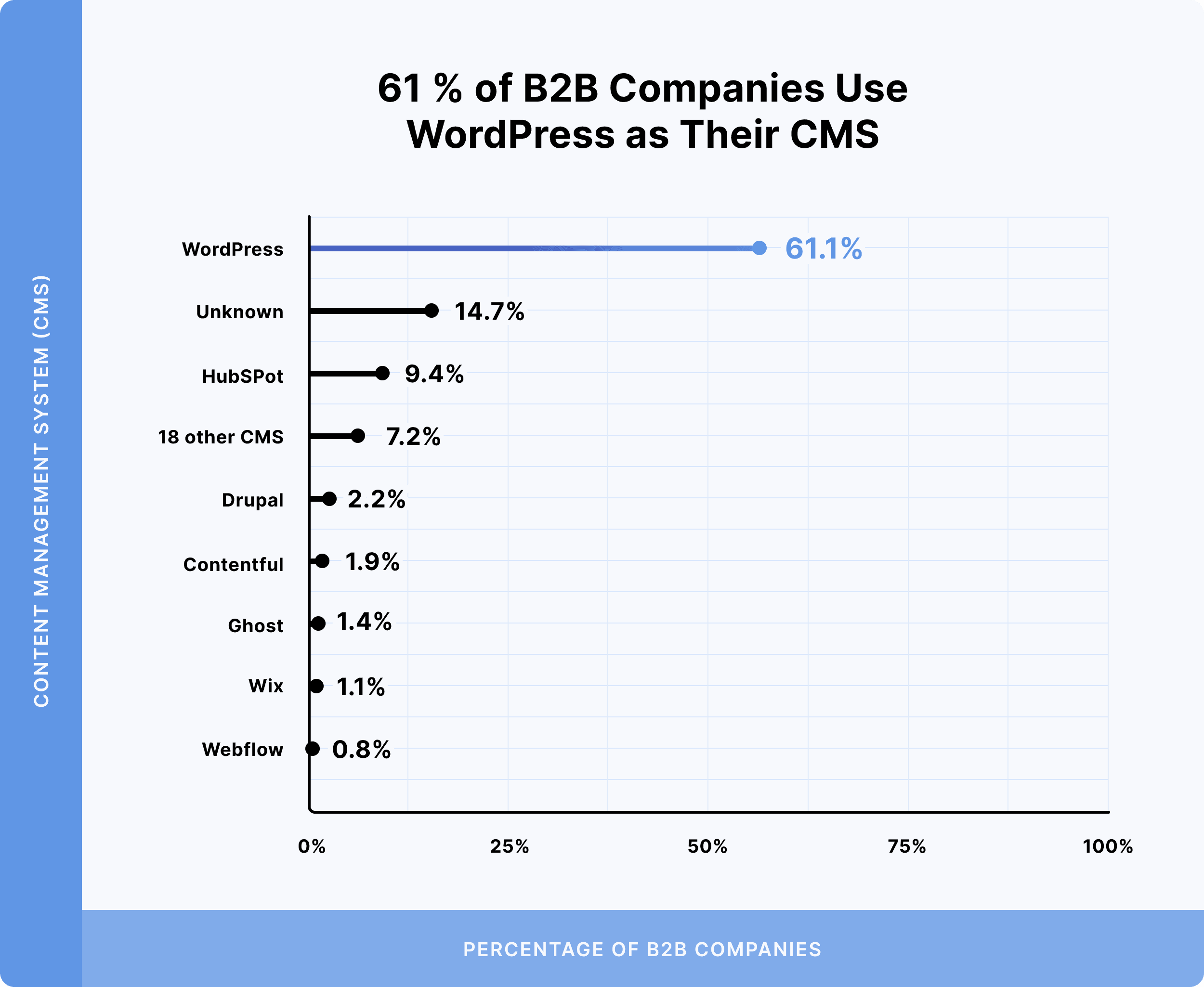
Note: We weren’t able to discover the CMS used by 53 of the companies on our list (10.5%). These may have been custom-built solutions or CMSs that are not commonly used.
According to BuiltWith, WordPress is the world’s most popular CMS.
So the fact that WordPress came out on top shouldn’t come as a surprise.
However, powering 61% of all B2B blogs, it’s interesting just how dominant WordPress is in the B2B world. To put this figure into perspective, the second most-popular CMS was HubSpot. Which was used by just 9% (34) of the companies we looked at.
Key takeaway: WordPress is the most popular choice of content management system for B2B companies – by far. HubSpot was the second most popular CMS among the B2B blogs that we analyzed.
38% of B2B Company Blogs Publish Content to Educate Their Audience
Across the companies we looked at, there were four distinct use cases for company blogs:
- Company news: these blogs only focus on the company and its products.
- Educational content: these blogs share helpful content that is designed to solve problems and provide value to the reader.
- Mixed: the company shares its press and educational content in one place.
- Industry news: Blogs that focused on sharing news relating to the industry they’re in.

The “mixed” approach was most popular, used by 51% of companies. This all-in-one strategy is likely popular because it has the best of both worlds.
Most content is focused on providing valuable content that educates an audience on a problem they’re looking to solve. The blog is also where a company publishes company-focused content that position’s their company as an industry leader.
An example of this “mixed” approach is from Segment. All their blog posts sit within one directory (segment.com/blog/). But each post is clearly separated into different categories depending on the subject matter or post type:
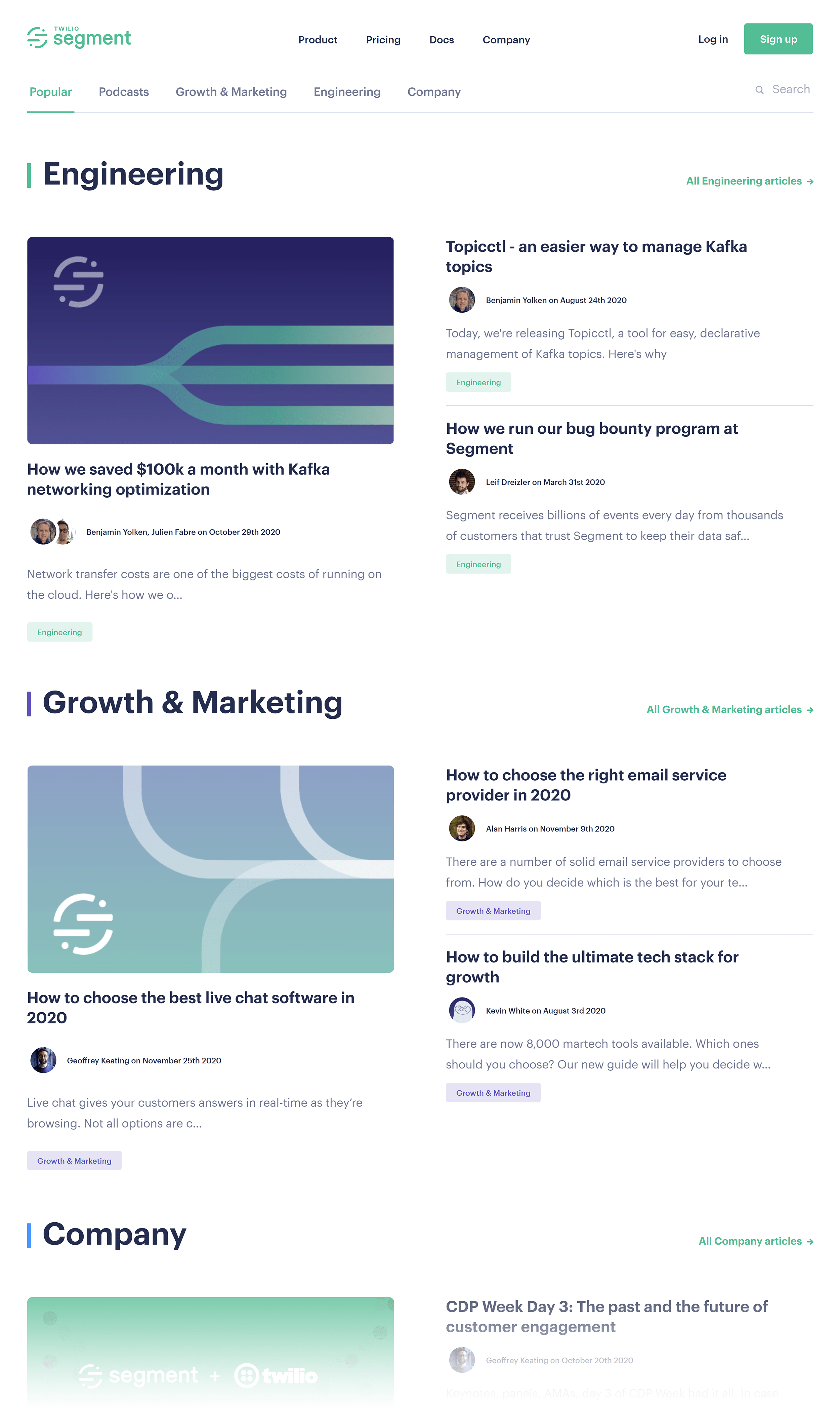
As you can see in this screenshot, their blog posts are very clearly categorized into themes: company-related posts (such as the announcement of Segment’s acquisition by Twilio) in one category, and educational posts relating to growth and marketing in another category.
38% of the blogs that we analyzed publish 100% educational content on their blog.
Interestingly, only 8% of companies solely used their blogs for PR-style, company news-focused content.
This suggests that if a B2B company is investing in their blog, they understand they’re likely to see better results by providing useful content for their audience vs. company updates and news.
Key takeaway: 51% of B2B blogs use their blog as a home for all their content – both educational and company-focused.
Educational Blogs Receive 52% More Organic Traffic Than Company-Focused Blogs
We found that educational blogs receive 52% more organic traffic than those which focused on company news and PR-style content:

This finding isn’t entirely surprising: educational content is more likely to rank for a wider variety of keywords. On the other hand, a business that’s only publishing news is limited to ranking for their company name and a handful of other related terms.
Key takeaway: Blogs that focus on educating their audience (rather than promoting their own company) receive 52% more organic traffic than company-focused blogs.
Only 29% of B2B Blogs Allow Readers to Leave Comments
Are B2B brands publishing content to create a community with their audience? Or is it a one-way street?
Our research found that only 106 (29%) of the B2B blogs we looked at allow readers to leave comments.
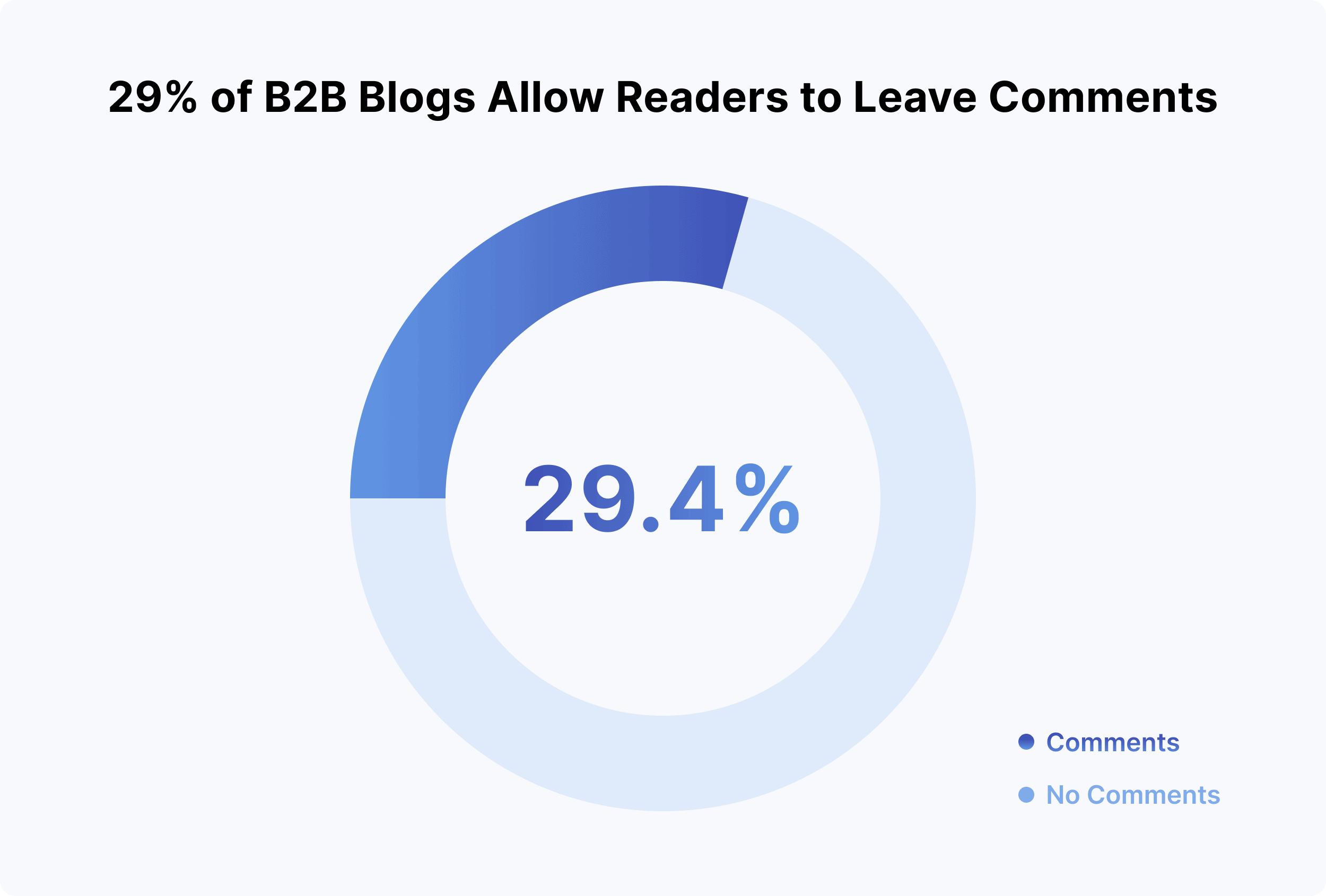
Allowing comments isn’t necessarily a “best practice” for blogs anymore. There’s certainly a case to be made that comments can lead to more site engagement. However, the data is unclear on whether comments actually generate more traffic and links.
Comments also come at a cost: moderation and fighting spam. And according to our data, most B2B companies prefer to run their blogs without a commenting feature.
Key takeaway: 70% of B2B blogs don’t allow readers to leave comments on their posts.
65% of B2B Blogs Use Stock Images
65% of the blogs we looked at used stock images as their featured image. 14% used no images at all. And only 21% of blogs used custom images for their posts.

Using stock images is an easy way for busy content managers to bring visuals into their posts.
However, during this study, we saw the same stock images crop up multiple times on different blogs.
In 2019, Reboot conducted a long-term experiment to investigate whether stock images (which are often used across hundreds of other sites) are treated by search engines as duplicate content, and as a result cause a ranking issue. They concluded: “Using unique images on your website does have a positive impact on organic web rankings… compared with equivalent sites using duplicated images across the web.”
While it’s impossible to draw wide-sweeping guidelines based on a single SEO experiment, it’s fair to say that custom images can help your blog content stand out. Which may make creating unique images worth the investment regardless of any potential SEO benefit.
Key takeaway: Almost two-thirds of B2B blogs use stock images for their content’s featured image.
23% of B2B Blogs Don’t Have a Call-To-Action
Content can be an excellent source of traffic for B2B blogs. But with typical bounce rates hovering at around 50%, a clear call-to-action can help convert that traffic into a lead or trial.
We found eight different types of call-to-action used across the B2B blogs in our data set:
- Subscribe to our blog/newsletter
- Related/recommended articles
- Download gated content
- Book a demo
- Start product trial
- Sign up
- Contact us
- View pricing
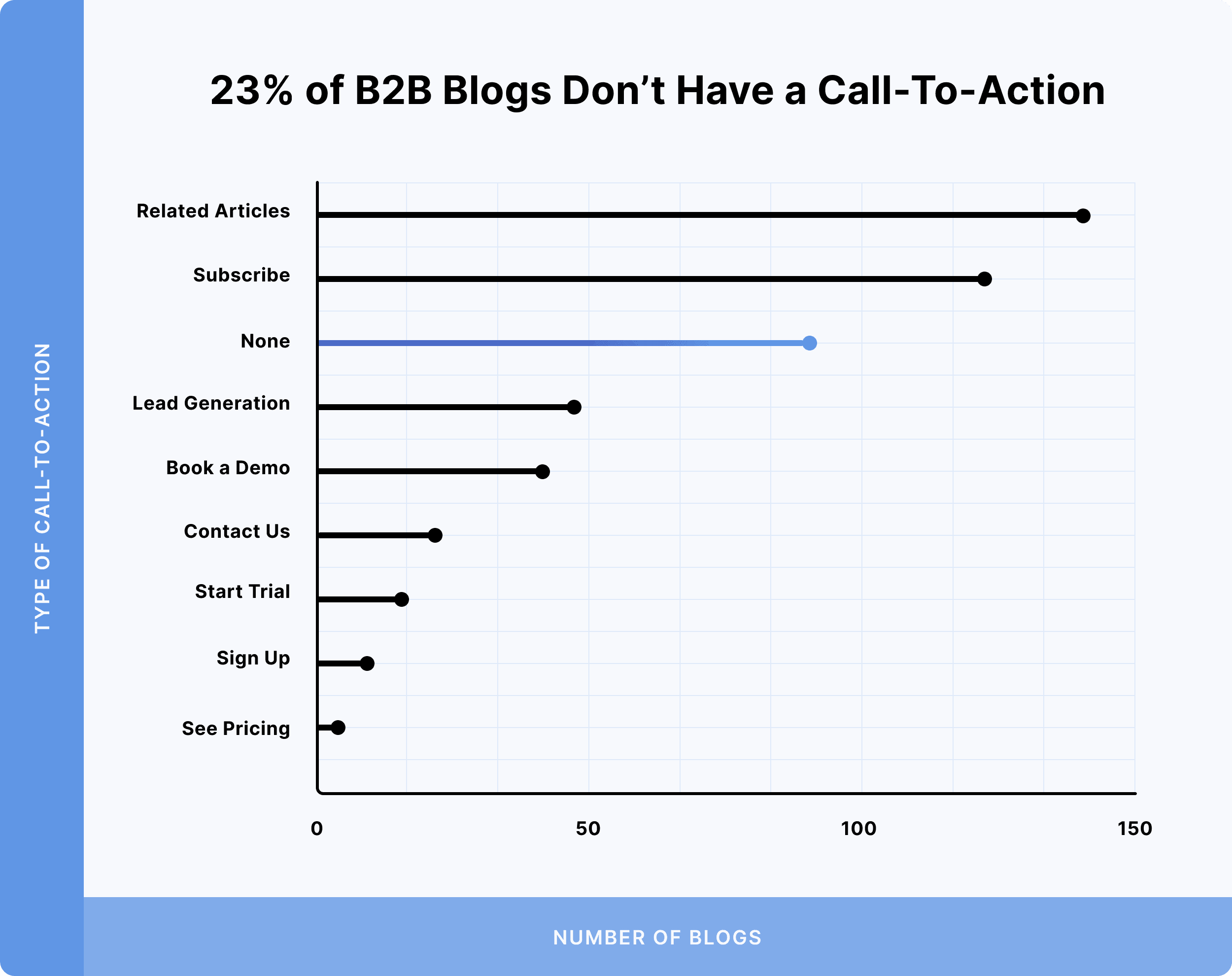
Note: several companies used more than one type of call-to-action on their blogs.
The most popular type of call-to-action was to show-case related articles, used by 39% of companies. The second most-popular call-to-action was to subscribe to their newsletter, used on 35% of blogs.
This data suggests that many B2B companies understand the importance of using their content to build ongoing relationships with their audience and to encourage multiple pageviews.
Interestingly, almost one-quarter of the blogs that we looked at didn’t use any type of call-to-action.
Key takeaway: 39% of B2B companies use “related articles” as a call-to-action on their blog. This is an even more popular CTA than “subscribe to the newsletter”, which was only used by 35% of companies. 23% of B2B blogs don’t have any CTA at all.
24% of B2B Companies Use Pop Ups On Their Blogs
Our research found that only 24% of B2B companies were using pop-ups on their blogs.
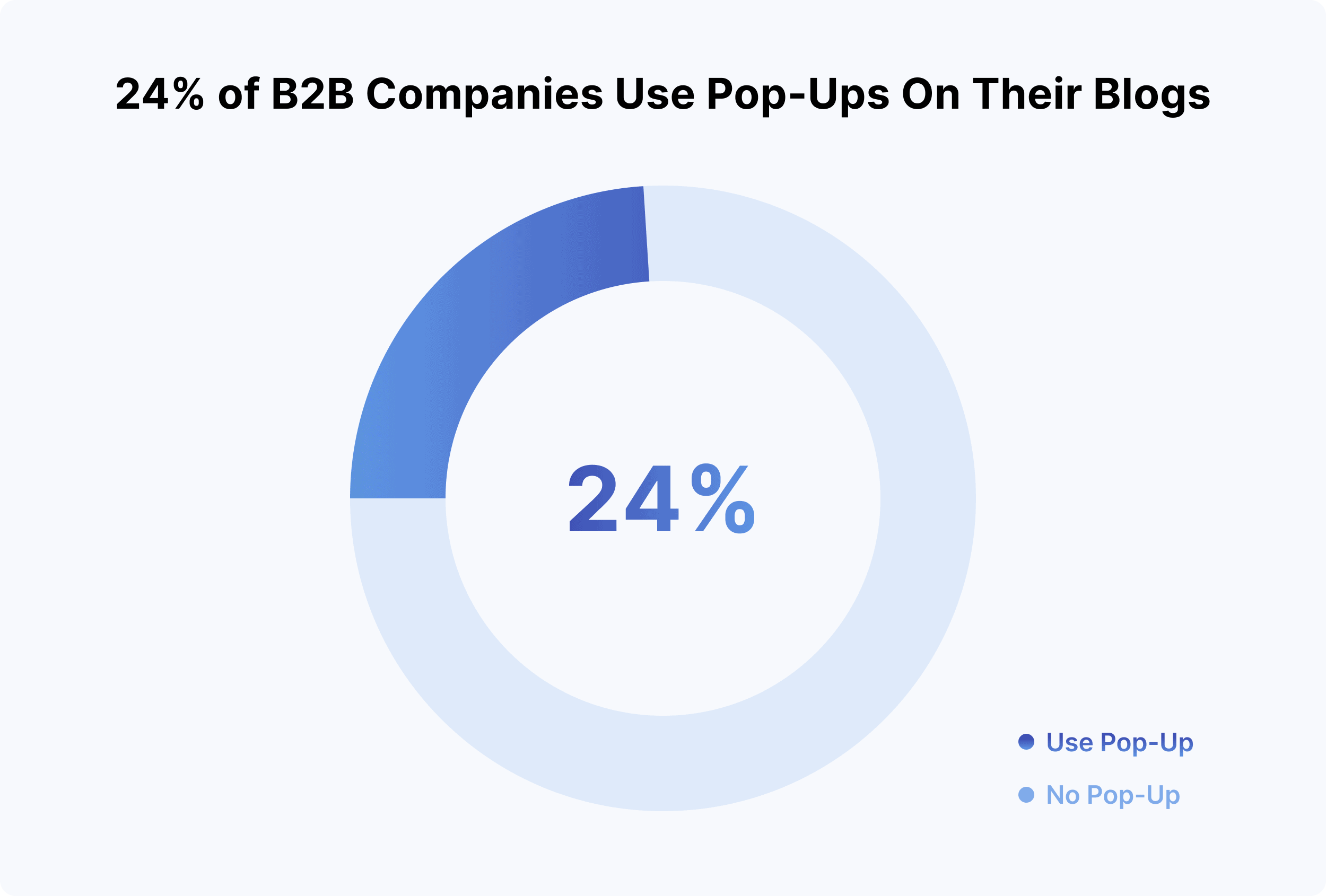
Note that we didn’t consider cookie notifications a popup. As that’s a legal requirement in certain instances.
Of the 88 companies that did use pop-ups, we saw nine different types:
- Subscribe to newsletter
- Promote specific content
- Book product demo
- Sign up to product
- Allow browser notifications
- Contact us
- Complete a survey
- Start free trial
- Company announcement
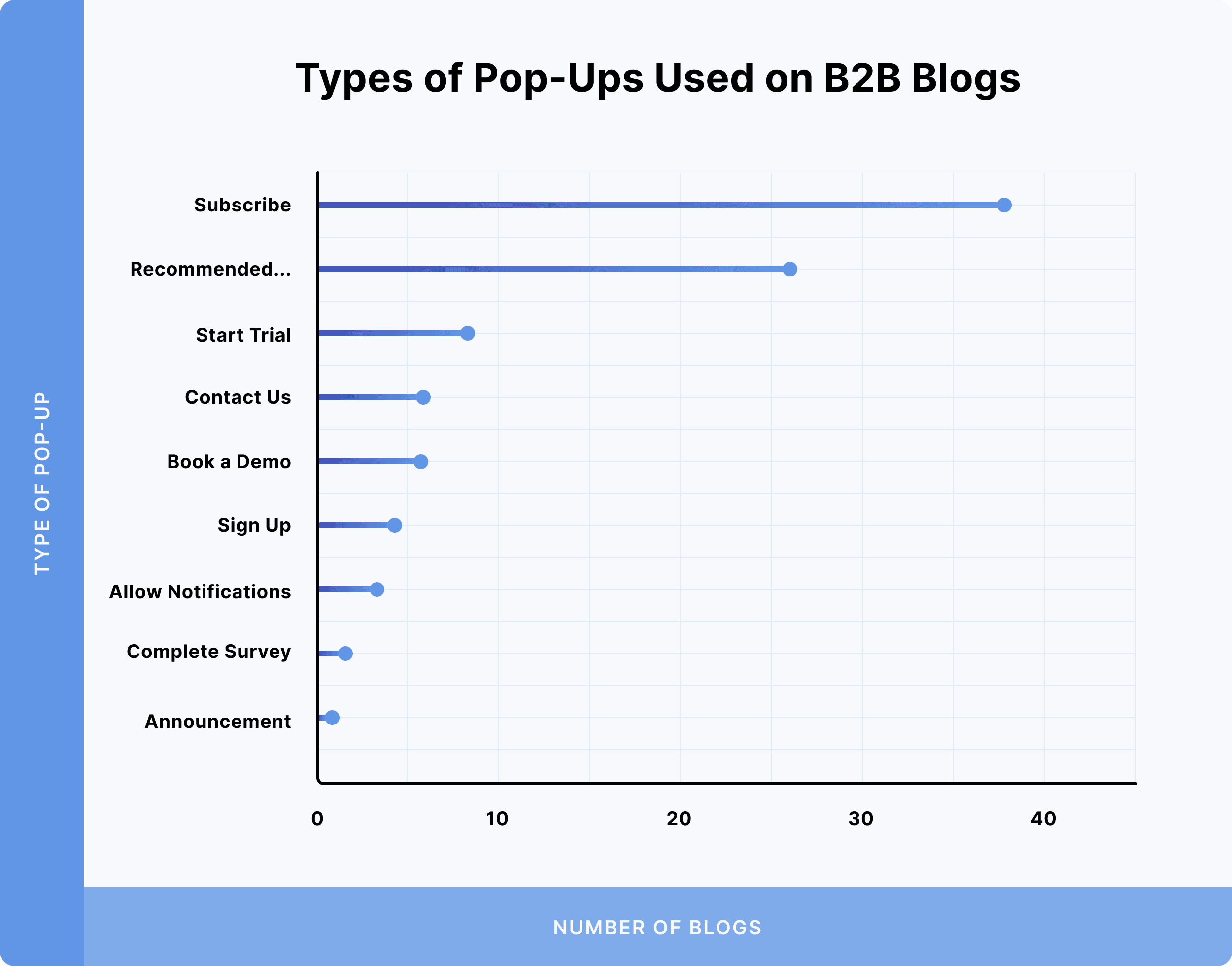
An example of this is from Grammarly. They use a pop-up on their blog to encourage visitors to sign-up for a free trial.
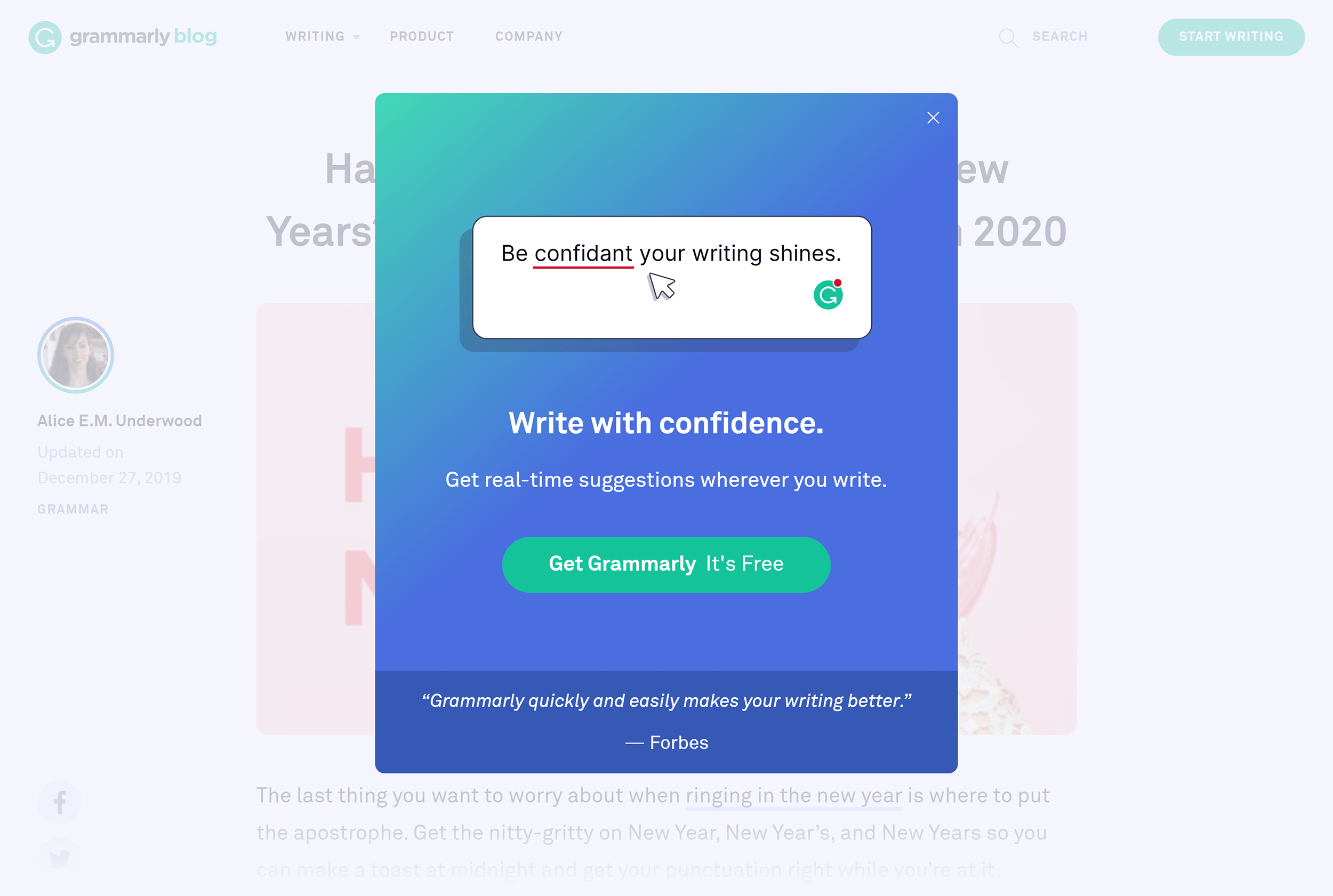
Or this example from Pindrop, who use a pop-up to promote recommended content (in this case an upcoming webinar).
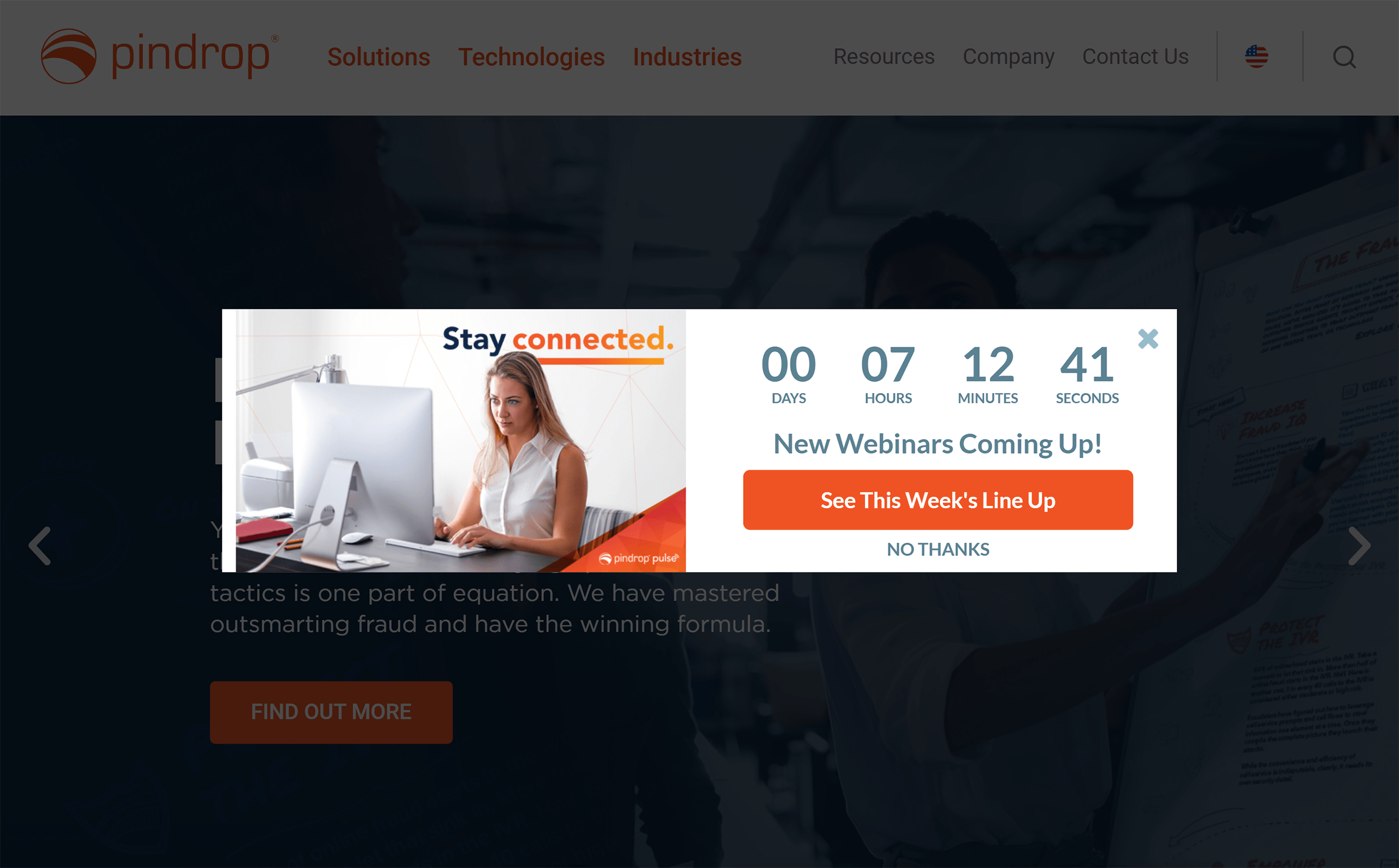
The most popular types of pop-up asked visitors to subscribe to a newsletter (41%) and to promote specific content (28%). Again, this shows that the majority of B2B companies are focused on building a relationship with their audience vs pushing product demos or sign-ups right away.
Key takeaway: Only 24% of B2B companies are using pop-ups on their blogs. But those that do, the most popular type of pop-up is encouraging visitors to subscribe to their newsletter (accounting for 41% of the blogs with pop-ups).
B2B Blogs Get an Average of 282 Visits From Organic Search Each Month
Next, we decided to look at the SEO performance of the blogs in our dataset in terms of organic traffic and keyword rankings.
(Note that the data here is an analysis of the entire blog. Not individual blog posts)
We found that the average B2B blog receives 282 visits from organic traffic each month.

However, this finding doesn’t show the full picture.
| B2B websites | Visits from organic traffic (median) |
|---|---|
| All websites in our analysis | 280 |
| Top 10% | 22,000 |
| Bottom 10% | 0 |
As we can see in the table above, there’s a significant amount of variance in organic traffic levels among the sites in our dataset. While the top 10% of blogs receive a median of 22,000 visits from organic search each month, the bottom 10% get essentially zero.
In fact, 32 of the sites we looked at didn’t get any traffic from organic search – and 70 of them were getting less than 10 visitors from SEO per month.
We also looked at the number of keywords that a typical B2B blog ranks for in Google organic search.
We found that on average B2B blogs rank for 784 keywords. But as with organic traffic, there’s a huge variance across the sites we looked at:
| B2B websites | Number of organic keywords (median) |
|---|---|
| All websites in our analysis | 784 |
| Top 10% | 34,550 |
| Bottom 10% | 2 |
On average the sites we looked at ranked for 784 organic keywords. But the top 10% ranked for 34,550 keywords. But the bottom 10%? Only 2.
Key Takeaway: The average B2B blog gets 280 visitors per month. However, this figure is slightly skewed by the significant number of B2B blogs that get little to no traffic from SEO. And the top 10% of B2B blogs that rank for thousands of popular keywords.
B2B Blogs Receive 1145 Backlinks From 120 Referring Domains
Backlinks and referring domains are an important factor in influencing search engine results. We found that, on average, B2B blogs receive 1,145 backlinks from 120 referring domains.
| B2B websites | Backlinks (median) | Referring domains (median) |
|---|---|---|
| All websites in our analysis | 1,145 | 120 |
| Top 10% | 147,000 | 2,560 |
| Bottom 10% | 4 | 2 |
We’ve previously outlined that we discovered huge levels of variance in terms of organic traffic and keyword rankings. And that pattern continues here.
In this case, the top 10% of B2B companies in our analysis have an average of 147,000 backlinks from 2,560 referring domains. However, the bottom 10% have only 4 backlinks from 2 referring domains.
Key Takeaway: The typical B2B business has links from 120 referring domains. We also found that top-performing B2B blogs received 2,560 referring domains on average.
Total Backlinks, Referring Domains and Keyword Rankings Correlate With Organic Traffic for B2B Blogs
Next, we looked at the relationship between backlinks, keyword rankings and organic traffic for blogs in the B2B space.
Our research found that there was a fairly weak correlation between both the number of backlinks and the number of visits from organic search.
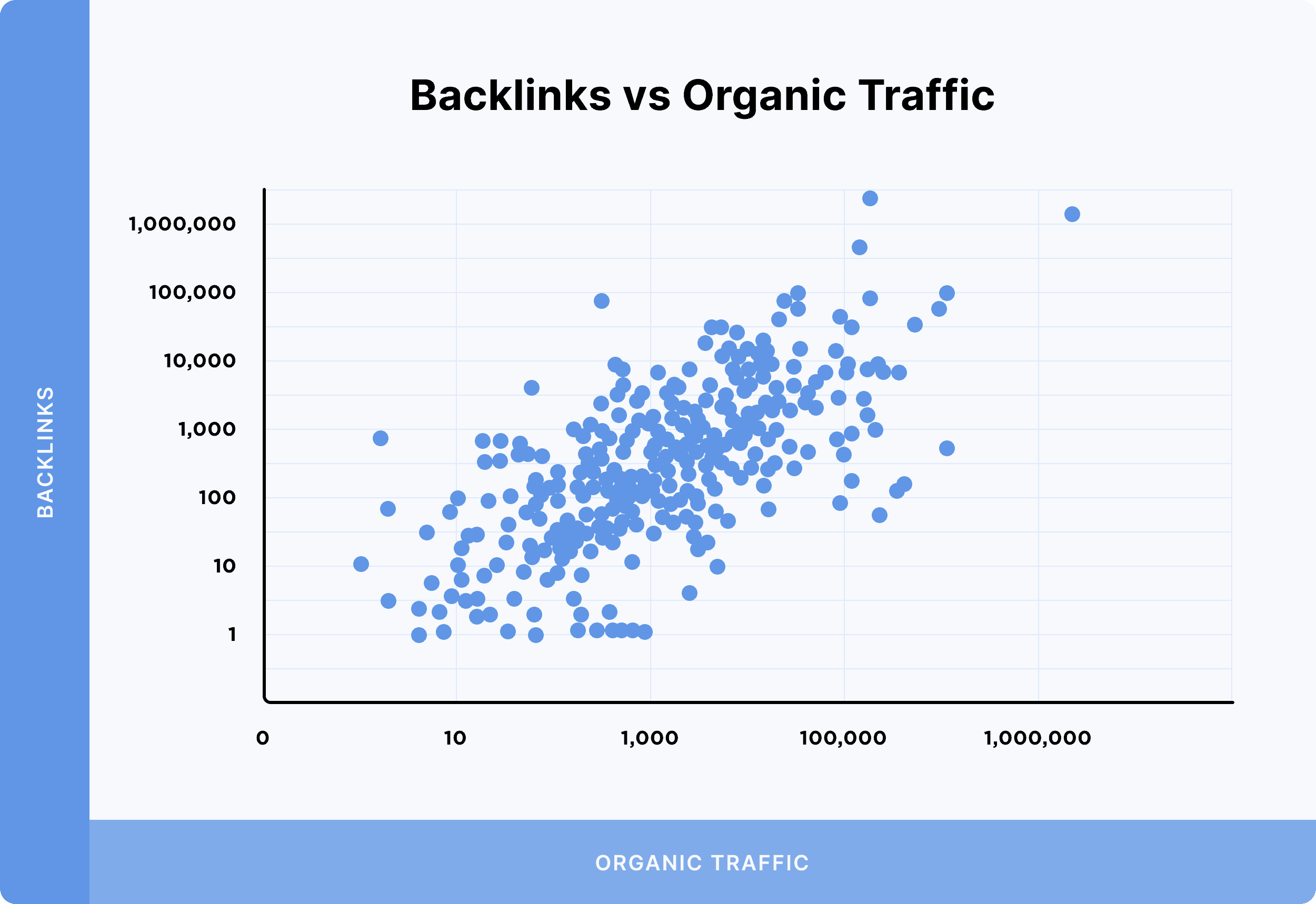
There was a stronger correlation between referring domains and organic search.

This suggests that it may be better to generate links from a number of different sites, rather than focus on getting a large number of links from the same set of sites.
These findings are in-line with other search engine correlation studies, like this and this.
Not surprisingly, there was a specially strong correlation between the number of keywords a blog ranks for, and how much traffic it gets from organic search:

Key Takeaway: Consistent with other correlational research, referring domains correlates with higher levels of the organic search traffic for B2B websites.
Top-Performing B2B Blog Posts Receive 49 Monthly Visits From Organic Search
So far we’ve focused on the analysis of B2B blogs as a whole. Now we’re going to switch gears and take a deep dive into the benchmarks that top-performing b2B blog posts tend to have.
Specifically, we identified each company’s best performing blog post, as measured by the organic search traffic it received each month.
Then, we analyzed each top performer in terms of organic traffic levels and keyword rankings.
| Top performing B2B blog posts | Visits from organic traffic (median) | Ranking keywords (median) |
|---|---|---|
| All websites in our analysis | 49 | 29 |
| Top 10% | 2,001 | 678 |
| Bottom 10% | 1 | 3 |
Our research found that the average best-in-class post ranked for 29 keywords and generated 49 visitors from organic search each month. 49 visitors may not sound like a lot of traffic. However, it’s important to keep in mind that B2B terms tend to be more commercially focused and have higher buyer intent when compared with B2C keywords. Also, organic traffic can often be reliable and consistent, especially when compared to traffic from the referral, direct traffic, social media or paid traffic.
As before, the top 10% of companies far out-perform the rest of the group. Their best posts rank for 678 keywords and generate 2,001 monthly visitors from organic search.
We also looked at the length of these top-performing posts. We cover that in more detail below.
Key Takeaway: Top-performing B2B blog posts tend to bring in 49 visitors from organic search per month.
Top-Performing B2B Blog Posts Generate 99 Social Media Shares
Social media is one of the most commonly-used channels for content promotion and distribution. But how successful is it?
We identified each company’s best-performing blog post, in terms of the number of social media shares it received:
| Top performing B2B blog posts | Social media shares (median) |
|---|---|
| All websites in our analysis | 99 |
| Top 10% | 3,000 |
| Bottom 10% | 2 |
Our research found that the average best-in-class B2B blog post gets shared 99 times on social media.
Again, the top 10% of companies far out-perform the rest of the group, with their best posts shared 3,000 times. At the other end of the scale, the bottom 10% were only shared twice.
Key Takeaway: While social shares vary greatly between blog posts, top-performing posts have an average of 99 social media shares.
Top-Performing B2B Blog Posts Receive Links From 12 Referring Domains
We identified each company’s best-performing blog post, in terms of the number of referring domains it received:
| Top performing B2B blog posts | Referring domains (median) |
|---|---|
| All websites in our analysis | 12 |
| Top 10% | 245 |
| Bottom 10% | 1 |
Our research found that on average, the top B2B blog post generates backlinks from 12 referring domains. While the top 10% received backlinks from 245 referring domains.
A previous study we did using data from BuzzSumo found that 94% of all blog posts have zero external links.
So while a median of 12 referring backlinks doesn’t sound like a lot, it’s infinitely more than what the vast majority of blog posts receive.
Key Takeaway: Top-performing B2B blog posts have 12 referring domain backlinks.
Long Form Content Performs Best In The B2B Space
Do longer blog posts perform better in B2B?
We looked at the word count for the top-performing blog posts across four different categories:
- Posts that generate the most organic traffic
- Posts that receive the most shares on social media
- Posts that generate the most dofollow backlinks
- And posts that get backlinks from the most referring domains.
On average, the best-performing posts (in terms of organic traffic) was 855 words long, compared with 1454 words for the top 10%, and 509 words for the bottom 10%.
For the top 10% best-performing posts in terms of social media shares, the average length is 1,116 words. Compared to 679 words for the bottom 10%.
For posts that generate the most dofollow backlinks, the average post is 780 words. Compared to 495 words for the bottom 10%.
And for posts that get backlinks from the most referring domains, the top 10% of posts contained 1552 words. The bottom 10% were only 554 words in length.
For all the metrics we analyzed, the trend is the same: the top 10% of posts are significantly longer than average, and the bottom 10% are significantly shorter.

Of course, a long post won’t automatically perform better just because it’s long. It needs to deliver value to earn those shares and links.
But our research does suggest that all things being equal, longer blog posts outperform shorter ones in the B2B space.
Key Takeaway: Long-form B2B content generates more social shares, backlinks, referring domains and organic traffic. For blog posts that rank well in organic search, the top 10% of posts are almost 3x the length of the bottom 10% of posts.
Conclusion
I hope you found this analysis of the B2B content marketing space interesting and useful.
I’d like to thank Emily Byford for helping me put this industry study together. For those that want to learn more about how we conducted this research, here’s a link to our methods and the raw data used for this analysis.
Backlinko is owned by Semrush. We’re still obsessed with bringing you world-class SEO insights, backed by hands-on experience. Unless otherwise noted, this content was written by either an employee or paid contractor of Semrush Inc.